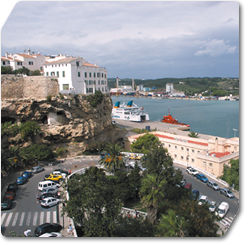- Villa search

- Canaries
- Caribbean
- Croatia, Bulgaria and Hungary
- Cyprus
- Florida
- France and Corsica
- Greece
- Italy
- Lakes and Mountains
- Madeira
- Malta and Gozo
- Portugal
- South Africa
- Spain - Balearics

The north of the island is where most of the agriculture takes place. We were surprised to see familiar black and white Friesian cattle, the source of one of Menorca’s other gastronomic delights – cheese – and part of the legacy of nearly a hundred years of British rule in the 18th century. The Brits, like many others, invaded for one reason: they wanted the port of Maó. It’s the second deepest natural harbour in the world – Pearl Harbour is the deepest – and perfectly placed in the middle of the Mediterranean.
Another legacy of British occupancy is gin. Juniper trees grow wild all over the island, although I suspect the gin factory has a more formal source for its core ingredient. Walk through the elegant city of Maó to the harbour and there you will find the Xoriguer gin factory. This hospitable place has several tasting tables where bottle upon bottle of gins and liqueurs are placed alongside little sampling glasses for you to simply help yourself. There is no charge to go in and no pressure to buy anything, but the betting is you will!
Maó needs at least a day to explore. The British influence is clear in the architecture, much of which has been beautifully renovated over the last couple of years. There is a street market a couple of mornings a week. And in what was once a monastery above the harbour, you’ll find a covered artisans’ market built into the old cloisters.
Menorca has several Bronze Age – or Talayotic – villages, dating from around 1300 BC, which have been painstakingly excavated and preserved. On the way to explore one of them we took in the largest of the even older burial chambers, known as Navetas.
There is a tragic legend attached to this Naveta des Tudons, about two brothers and their rivalry for the affections of a beautiful girl. The gist of it is that one builds a house for her while his brother digs a pond as a water supply. In their race to complete these tasks and win the girl’s hand in marriage, both of them die and the poor girl ends up husbandless. Be that as it may, the Naveta is in remarkable condition. You can – if you are athletic enough – crawl inside to see the two levels of the chamber.
To find the Talayotic village of Torre Trencada, we followed faded purplish signs which guide you through narrow, winding lanes to a little car park. From there you walk along footpaths around a couple of fields until you reach the remains. They are fascinating. This village includes a sacred site for religious ceremonies, an underground stable, burial chambers, and an elaborate well.
If you are prepared to take a hair-raising drive down about two kilometres of potholed road, on the coast just a few kilometres south west of Maó is an even more stunning phenomenon. Cales Coves is a beautiful bay with towering cliffs peppered with dozens of caves. Some were homes, others were burial chambers. The stone around some entrances has been carved into formal doorways. The people of the pre-Roman civilisation that used them must have been built like mountain goats to reach them at all. Unfortunately you can’t put this to the test because all the caves have been sealed in the interests of safety and conservation.
home | destinations and editorial | villa search | property for sale | car hire | flights | services
villaseek blog | contact villaseek | links and resources | advertise your villa© Dune Root Ltd and Villaseek.com 2012 - Caribbean
- Canaries